by BASCOM KING

The SC-III falls about in the middle of Dunlavy Audio Labs' speaker line, which ranges from the small SC-I to the mammoth SC-VI. Like all but the SC-I, the SC-III is a tall speaker, some 6 feet high, but narrow and not very deep. For increased stability, it is supplied with a base 15 inches square.
John Dunlavy, the company's chief designer and CEO, engineers all of his speakers with accuracy as the main criterion. (Opinions on what this entails obviously differ; speaker manufacturers using wildly different approaches all claim it, even in the face of independent findings to the contrary.) Dunlavy, however, passionately believes that, to be accurate, a speaker should reproduce the waveform of the electrical input at some designated listening distance in a room. His speakers are de signed to deliver a time-coherent waveform, on axis, at a distance of about 10 feet. Dunlavy refers to this as "path and phase alignment," because it equalizes path lengths from each driver to the listener's ear. Almost no speakers deliver such waveform accuracy. Achieving it requires not only flat frequency response but also flat or linear phase response and simultaneous arrival of the signals from all drivers.
One way Dunlavy speakers reach this goal is through symmetrical array geometry. In the SC-III, for example, the five drivers are in a vertical array: 5-inch midrange drivers are above and below the 1-inch dome tweeter, while 6 1/2-inch woofers are above and below the midranges. Other techniques employed by Dunlavy include recessing the tweeter and midranges behind the plane of the woofers, use of carefully worked out first-order (6-dB/octave) crossover networks, and use of absorbent materials on the front panel and around the recessed drivers. This last strategy, on which Dunlavy held the original patent (now expired), virtually eliminates edge diffraction.
Together, these techniques make the company's speakers radiate sound very much like directional antennas (Dunlavy has patents in the antenna field, too); they direct most of their energy toward the listener and control sound radiation to the room's walls, ceiling, and floor. This, in turn, helps make the frequency response you hear more even. For example, a speaker with a single woofer will often have a dip in its lower midrange, caused by cancellation between the direct sound from the woofer and the slightly delayed sound of its output bouncing off the floor. The Dunlavy speakers' two-woofer vertical array reduces this effect because the array becomes direction al in the lower midrange, reducing the amount of energy radiated toward the floor.
----------------------
Rated Frequency Response: 45 Hz to 20 kHz, ±2 dB;-3 dB at 40 Hz.
Rated Sensitivity: 90 dB SPL at 1 meter, 2.83 volts applied.
Rated Impedance: 3 to 5.5 ohms; 4 ohms, nominal.
Dimensions: 72 in. H x 12 in. D x 9 in. W (182.9 cm x 30.5 cm x 22.9 cm).
Weight: 85 lbs. (38.6 kg), including base.
Price: In light or black oak, $3,995 per pair; in rosewood or cherry veneer, $4,495 per pair.
Company Address: P.O. Box 49399, Colorado Springs, Colo. 80949; phone, 719/592-1159; fax, 719/592-0859.
----------------------
TEST EQUIPMENT USED
Test Signal Sources: DRA Laboratories MLSSA (Maximum Length Sequence System Analyzer) in a PC, Hewlett Packard 239A oscillator, and IEC F37 function generator
Acoustical Data Acquisition: Brüel & Kjaer Model 4133 calibrated instrument microphone with Type 2804 power supply and custom-made microphone preamplifier
Data Analysis: MLSSA measurement system, oscilloscope, and Hewlett Packard 3580A spectrum analyzer
-----------------------
Measurements
Most of my measurements of the SC-IIIs were made in Dunlavy Audio Labs' large test chamber, which is much better suited to this sort of work than any room normally available to me. The chamber is essentially anechoic down to about 125 Hz, but it is possible to make accurate measurements below that frequency, using correction factors for the chamber's acoustic modes. The measurements made in this chamber, and some made in my lab, were analyzed with a DRA Laboratories MLSSA.
For Fig. 1A, I plotted the SC-III's frequency response only from 200 Hz to 20 kHz. Over this range, response is very flat, within about ±1 dB! What's more, the other speaker of the pair was within about 0.5 dB of this response, which is exception ally close. With the measurement range ex tended down to 20 Hz (Fig. 1B), the effects of the chamber's room modes can be seen; the dashed curve represents bass response after these effects are factored out. The-3 dB point is about 40 Hz, right on spec.
One measure of a speaker's path and phase alignment is its reproduction of step waveforms. Like a stair step, the signal rises abruptly from one steady DC level to an other and remains at the new level. But be cause speakers act as bandpass filters, they can't pass DC; a speaker's passband normally ends at around 20 to 100 Hz in the bass and at perhaps 15 to 50 kHz in the treble. The step response of an ideal speaker would rise straight up, with no overshoot or ringing, then roll off exponentially to zero (its original level) over a time period that relates to the speaker's low-frequency cut off. (In practice, there will always be some finite rise time, which means the rise will not be straight up.) If a speaker is not path and phase aligned, its tweeter signal almost always arrives first, as a narrow spike, followed by the usually broader pulse of the midrange signal and, finally, by the signal from the woofer. The tweeter, midrange, and woofer signals may or may not have the same polarity. Such a speaker's step response is shown in Fig. 2A. The tweeter and mid range outputs have the same acoustic polarity, but the woofer's contribution appears to have the opposite polarity. How ever, the SC-III's step response (Fig. 2B) comes very close to meeting the previously discussed criteria.
Another sign of the SC-III's path and phase alignment is its phase response (Fig. 3). If this alignment were perfect, the phase response would be a straight line-horizontal if there were no delay and sloping down when there is delay, as seen here. The slope is a function of the delay in the speaker-but more important, the properly aligned speaker's delay is constant with frequency, producing the linear phase curve in Fig. 3. This is very good phase linearity, among the best I've seen from a loud speaker.
A speaker's output should not only rise quickly, as seen in its step response, but also decay quickly when a tone is suddenly cut off.
Energy storage caused by resonances or excessive phase shift in a speaker will slow the decay, especially at frequencies where the speaker resonates. This is illustrated by a plot of cumulative spectral decay (Fig. 4). In this "waterfall" plot, the SC-III's normal frequency response was derived from a Fast Fourier Transform of its time-windowed impulse response. As you move toward the front of the plot, the time window changes for each curve, so that each shows the speaker's output a fraction of a millisecond later than the previous curve.
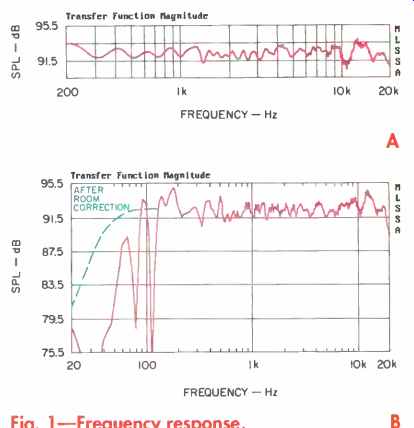
Fig. 1--Frequency response, from 200 Hz to 20 kHz (A) and from 20 Hz
to 20 kHz (B), measured 10 feet from the Dunlavy SC-III in an anechoic
chamber.
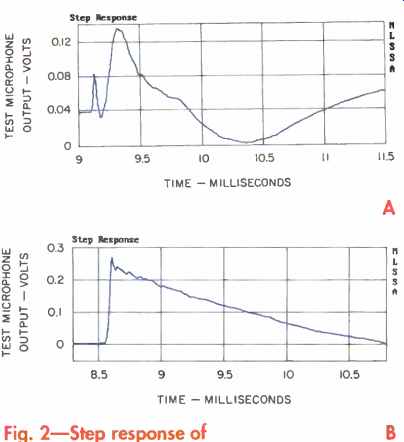
Fig. 2-Step response of a speaker without path and phase alignment (A)
and of the SC-III measured 10 feet away in an anechoic chamber (B).
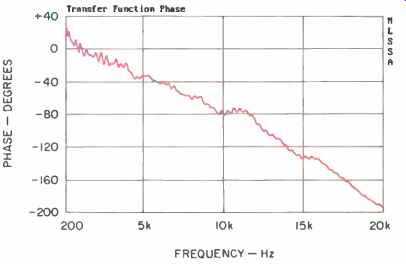
Fig. 3-Phase response.
The peaks and dips in a speaker's decay spectrum are a good indication of its resonances. If a speaker has good path and phase alignment, the amplitude of the second curve from the rear will drop sharply, as the SC-III's does in Fig. 4. If a speaker has excessive phase shift, its energy storage will keep the successive curves from dropping in amplitude as quickly.
Figure 5 shows how the SC-III's response changes as you move to one side of its forward axis. There is little change for listening positions as much as 30° to one side.
Because of the speaker's symmetry, results are the same to either side.
That symmetry also explains why I plotted response below, but not above, the forward axis (Fig. 6), especially as I was measuring only within 30° of the axis; any listeners farther off this axis would probably be on the floor or ceiling.
All the preceding measurements were made at 10 feet, the Dunlavy speakers' designed working distance. To see how some of these results would fare at the standard microphone distance of 1 meter, I tested on-axis frequency response and step response at a distance of about 3 feet, which is within a few inches of a meter. The frequency response (Fig. 7A) is not as flat as in Fig. 1, and the step response (Fig. 7B) isn't quite as good as that in Fig. 2B. Though the SC-IIIs still sounded good from 3 feet away, they're likely to sound best when they're closer to the 10-foot distance recommended by Dunlavy, which is about where you're likely to sit anyway when using speakers of this size.
I also measured total harmonic distortion plus noise (THD + N) at a microphone distance of 10 feet in the anechoic chamber (Fig. 8). The input was 2.83 volts, equivalent to 1 watt into 8 ohms or 2 watts into a 4-ohm speaker such as this. (As in Fig. 1A, this produced a fairly loud 92 dB SPL or so from the SC-III.) The dip at 100 Hz in Fig. 8 is most likely caused by a room mode in the chamber near that frequency;
the apparent lessening of distortion above about 7 kHz is caused by the measurement system's anti aliasing filter. Because the SC-III's distortion is highest in the bass, I retested low-frequency distortion at the original level of 2 watts and at one-fourth and four times that power (Fig. 9); these are close-miked measurements made in my listening room using the DRA Laboratories MLSSA. The SC-III produced reasonable distortion levels, typical of speakers in its general size and price range.
John Dunlavy believes it's important that a speaker's impedance stay within reason able limits. The SC-III exemplifies this with an impedance magnitude ranging from a bit less than 3 to about 7.5 ohms and an impedance phase angle that varies only from about +19° to-31° (Fig. 10).

Fig. 5--Horizontal off-axis frequency response.

Fig. 6--Vertical off-axis frequency response.

Fig. 7--Frequency response (A) and step response (B), measured 3 feet
from the SC-III in the listening room.
Use and Listening Tests
I first heard the Dunlavy SC-IIIs in Bel Canto's room at the 1998 Winter Consumer Electronics Show, where I and a highly critical friend agreed that their sound was very good. The next time I heard these speakers was in Dunlavy Audio Labs' large, acoustically treated sound room; my review pair of SC-IIIs and a pair of SC-IV-As were set up side by side on one of that room's long walls. The angle of separation between the speakers of each pair, at 130° or so, was very wide. With a setup like this, you have to sit right in the center to get the full effect. If you move to either side, the image quickly shifts in that direction, but oh, in the middle, what a sound!
The music I listened to included my own CDs, some from the company's library, and some DAT recordings of the Colorado Sym phony made personally by Dunlavy with Brüel & Kjaer instrumentation mikes. In some cases, the sound was among the best and most realistic I've heard in terms of tonal honesty, imaging, and dynamics.
Some recordings, however, didn't have enough center fill for such a wide angle between the speakers.
As I switched back and forth between the two sets of speakers, I was most impressed with how much alike they sounded, even though the SC-IV-As are about $2,000 more per pair. I did hear more extended bass from the SC-IV-As' 10-inch woofers than from the 6 1/2-inchers in the SC-IIIs. However, when Dunlavy swapped the positions of the speaker pairs, I was surprised to find that the SC-IIIs' bass response was much better than I had thought--a gentle reminder that speaker placement is vital to sound quality. In my own listening room, which is neither symmetrical like Dunlavy Audio's sound room nor large enough for such wide-angled placement, I'd thought the imaging would not be as precise and stable as it had been at the factory, but my concerns were unfounded. Moreover, I think my room is more typical of the rooms potential buyers will have.
At first, I placed the Dunlavy Audio Labs SC-IIIs near the usual locations of my B&W 801s, well out in the room. With this placement, a recording whose sound I had not liked previously immediately sounded more lifelike-a very good sign. Experimentation showed me that bass was a bit better with the SC-Ills set back from these positions. When I set them further forward, the soundstage became quite a bit more spacious, but the timbre was too bright for my taste. Overall balance was quite good, but the bass was not as deep and robust as with my 801s. That wasn't unexpected, given the SC IIIs' higher bass cutoff frequency, but I believe the low-frequency response would be better in a more typical, regularly shaped, reason ably closed room-which mine is decidedly not. Even so, I did get very good bass that was tight and musical.
After further experimentation, I wound up placing the SC-Ills quite forward in the room, as far apart as I could get them. I angled them in ward (which Dunlavy recommends), so that they directly faced my listening position. With this setup, the SC-IIIs' imaging, spaciousness, tonal honesty, and over all musical believability were exceedingly good. With many of the recordings I used, the soundstaging was most impressive, though on some the image was more likely to collapse into the left and right speakers than with the 801s. Generally, however, I was amazed at the large and realistic soundstage I heard from most of my recordings.
I also got an astonishing sense of clarity and detail on much of the music I played, though several recordings sounded noticeably edgier and brighter through the SC-IIIs than through the 801s.
Since the SC-IIIs were rather unforgiving of less than stellar source material in my room, I used the digital equalizer in the Z-Systems RDP-1 preamp to attenuate the highs and lift the bass a bit for such recordings; I also used the loudness-compensation and tone controls of an old Dyna PAS 2 tube preamp to very good effect.
I did not notice any of these anomalies when I heard the SC-IIIs in the manufacturer's sound room, so I expect that they would not show up in some other installations, or even bother all listeners, for that matter. However, the SC-IIIs make it easy to hear differences between good and bad recordings as well as between various amps and source components.
Overall, I am most impressed with the SC-IIIs and give them very high marks. I enjoyed reviewing them and would definitely recommend them--or any of Dunlavy Audio Labs' other speakers--for consideration by serious listeners.
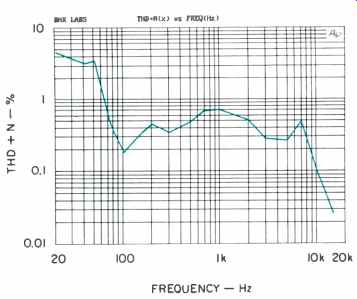
Fig. 8-THD + N vs. frequency, measured 10 feet from the SC-III in an
anechoic chamber.
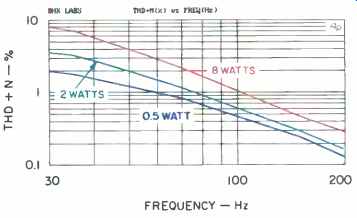
Fig. 9-Near-field measurements in the listening room of woofer.
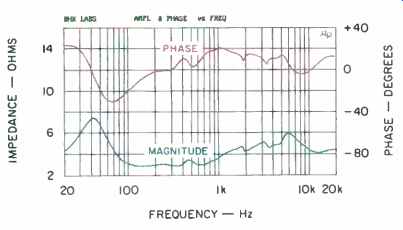
Fig. 10--Impedance.
----------------------
ASSOCIATED EQUIPMENT USED
Equipment used in the listening tests for this review consisted of:
CD Equipment: PS Audio Lambda Two Special and modified Sonic Frontiers SFT-1 CD transports, various CD players, Genesis Technologies Digital Lens anti-jitter device, and Classé Audio DAC-1 and Sonic Frontiers Processor 3 D/A converters
Phono Equipment: Kenwood KD-500 turntable, Infinity Black Widow tonearm, Win Research SMC-10 moving-coil phono cartridge, and Vendetta Research SCP2-C phono preamp
Additional Signal Sources: Nakamichi ST-7 FM tuner, Nakamichi 1000 cassette deck, and Technics 1500 open-reel recorder
Equalizers: DGX Audio DDP-1 and Z-Systems RDP-1 digital preamps
Preamplifiers: Sonic Frontiers Line-3, Dynaco PAS 2, and Kora Electronic Concept Eclipse
Amplifiers: Arnoux 7B stereo switching amp, Reference Line Audio Preeminence Model 1 Class-A stereo amp, prototype amp by James Bongiorno, Quicksilver Audio M135 and Kora Electronic Concept Triode 100SB mono tube amps, and Audio Note Conqueror and Bel Canto SET 40 single-ended stereo tube amps
Loudspeakers: B&W 801 Matrix Series 3s and Lowther PM5A drivers in modified Lowther Club Medallion II cabinets
Cables: Digital interconnects, Illuminati DX-50 (AES/EBU balanced); analog interconnects, Transparent Cable MusicLink Reference (balanced) and Tara Labs Master and Music and Sound (unbalanced); speaker cables, Transparent Cable MusicWave Reference, Jena Labs Speakeasy Twin Three, and Audio Note Custom
-----------------------
(Source: Audio magazine, Jul. 1998)
Also see: